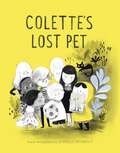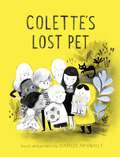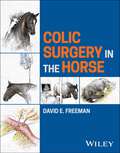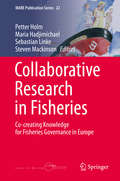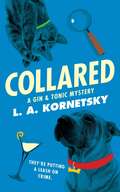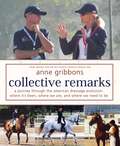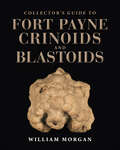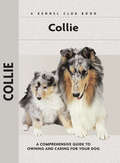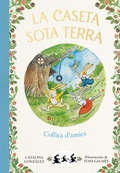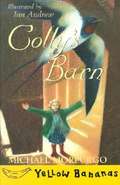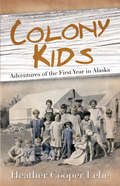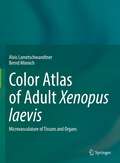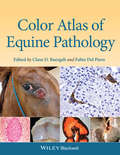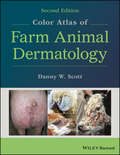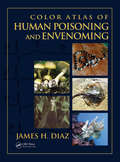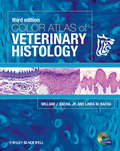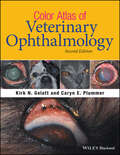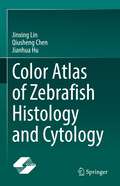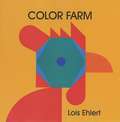- Table View
- List View
Colette's Lost Pet
by Isabelle ArsenaultColette can't find something to talk about with the new kids in the neighborhood...so she invents a pet! Her fib quickly escalates, and suddenly her parakeet is a larger-than-life world-traveler named Marie Antoinette. Have her new friends figured out her secret? What will they do?This charming story both clearly identifies the struggle of navigating a different experience, and demonstrates to kids a lovely and welcoming way to treat someone new in their community.
Colette's Lost Pet (A Mile End Kids Story #1)
by Isabelle ArsenaultA charming and funny story about navigating new places and friendships. Perfect for fans of Uni the Unicorn and Sparky.Colette is exploring her new neighborhood and wants to make friends. But when she encounters someone her age she&’s never met before, she doesn&’t know what to say—so she hastily invents a lost pet! Things spiral a bit out of control as a neighborhood-wide search party is assembled and Colette makes her pet bird more amazing with each telling. Will the neighborhood kids catch on to her ever-growing fib? This charming story both clearly identifies the struggle of navigating a different experience and demonstrates to kids a lovely and welcoming way to treat someone new in their community.
Coley's Journey (Fountas & Pinnell Classroom, Guided Reading)
by Jean KnoxNIMAC-sourced textbook. GPS Is for the Birds! Where do ospreys go when they migrate every year? Scientists wanted to find out, so they put a small backpack on an osprey. Inside the backpack was a tiny GPS device. Now ospreys are flying for science!
Colic Surgery in the Horse
by David E. FreemanA comprehensive discussion of surgical treatments for equine colic Colic Surgery in the Horse presents a detailed exploration of surgical procedures in the horse abdomen. It is a state-of-the-art reference for equine surgeons, providing detailed descriptions of surgical treatments for colic in horses. The book offers step-by-step instructions for abdominal surgeries in the equine patient with accompanying photographs and illustrations. Covering all aspects of colic surgery, the book emphasizes a practical approach designed to improve outcomes after surgical treatment. Numerous illustrations accompany the discussions of colic surgery, diseases causing colic, treatment decision making, preoperative considerations, postoperative treatment, and other related topics. The book is an accessible, essential resource for all veterinarians engaged in the surgical treatment of colic in horses. Readers will also find: A thorough introduction to diseases of the stomach, small intestine, and large intestine that cause colic in horsesComprehensive explorations of the assessment of colicPractical discussions of owner-involved decision making in the treatment of equine colicComplete coverage of preoperative management and anesthesia and surgery preparationAn emphasis on a practical approach designed to improve outcomes following surgery Written for equine surgeons, residents and interns, Colic Surgery in the Horse will also benefit equine veterinary practitioners with an interest in the treatment of colic in horses.
Collaborative Research in Fisheries: Co-creating Knowledge for Fisheries Governance in Europe (MARE Publication Series #22)
by Sebastian Linke Petter Holm Maria Hadjimichael Steven MackinsonThis book is about the ongoing transition of fisheries governance, from top-down command and control towards a more transparent and participatory form. It focuses on the emergence of research practices and advice frameworks that allow co-creation of common knowledge bases for management. Drawing from 8 years of research in GAP, a two-stage 7th framework EU project, the book offers a critical examination of how knowledge practices in fisheries governance are changing. The entry point for this research is a series of practical experiments in the unchartered terrain of collaborative research. To gain insight into the ongoing transition in European fisheries management, GAP initiated and carried out 13 Case Studies in different settings across Europe. In each case study, a team of fishers and marine scientists worked together to identify, plan and implement research projects intended to make a difference. The cases vary. They take on different management issues and shape the collaborations in different ways. The extent to which they succeed in realizing their objectives also differs. They are all contributing important insights into the possibilities of co-creating knowledge for management purposes. The book delves into the individual experiences of each case study as well as the lessons they contribute as a whole. The examination concludes that while research partnerships are not always easy to establish, they are an important step towards better fisheries governance. Without a common knowledge base for fisheries governance, co-created through collaborative research practices, sustainable fisheries will remain out of reach.
Collared: A Gin & Tonic Mystery (A Gin & Tonic Mystery #1)
by L. A. KornetskyThey rely on animal instincts… Meet “Gin” and “Tonic.” She’s a dog person. He’s a cat person. But when these two friendly rivals team up to solve a mystery, you can bet their pets aren’t the only ones getting collared…Ginny Mallard and her shar-pei, Georgie, are about to run out of kibble and cash, unless she digs up another client for her private concierge business. So she heads to her neighborhood Seattle bar, Mary’s, to sniff out an opportunity. Or a gimlet or two. The bartender, Teddy Tonica, is usually good for a round of challenging banter, and Georgie is oddly fond of his bar cat, Mistress Penny. Before she can say “bottoms up,” Ginny lands a job tracking down some important business papers that have gone missing—along with the customer’s uncle. If Ginny hopes to track him down, she’ll need more than her research skills: she’ll need a partner with people skills—like Tonica. This is one dangerous case that’s about to go to the dogs—unless man, woman, cat, and canine can work together as one very unconventional crime-solving team.
Collective Remarks
by Anne GribbonsWorld renowned dressage judge and former US Olympic coach Anne Gribbons has had the unique experience of living the trajectory of the dressage evolution in the United States. A native of Sweden, Gribbons has been active in the US dressage scene since 1972, when dressage in this country was in its infancy. She has trained and shown sixteen of her own horses to Grand Prix, nine of which were long-listed for the United States Equestrian Team, and one of which—Metallic—was on the Olympic bronze-medal-winning dressage team in Atlanta under current US Dressage Team Technical Advisor Robert Dover.In addition to her equine students, Gribbons has coached many successful riders through the levels, and she has always been willing to share her experience and guidance in the form of clinics, lectures, and her popular column in the consummate American equestrian magazineThe Chronicle of the Horse. Over the course of almost 20 years Gribbons provided commentary on the state of dressage in the Unites States and around the world, tying together her diverse viewpoints from the ground, from the saddle, and from the judge's stand with her trademark style and wit. Now, the best (and in some cases, the worst!) of Gribbons' personal experiences as a rider, trainer, breeder, facility owner, sponsor, competitor, instructor, coach, and judge—first shared in herChroniclecolumns—are gathered into one immensely entertaining sourcebook of history, humorous anecdotes, attempts to learn from dressage's past, and prophesies about the sport's future. Anyone with an interest in dressage, its controversies, and its most famous names, will enjoy Gribbons' stories, but the true value is in her ideas for improving our horses, our riders, and our ability to compete on the international scene with success and integrity in the years to come.
Collector's Guide to Fort Payne Crinoids and Blastoids (Life of the Past)
by William MorganCollector's Guide to Fort Payne Crinoids and Blastoids is the first comprehensive guide for identifying the fossils of echinoderms from hundreds of millions of years ago, when North America was covered by a warm, equatorial sea.Crinoids and blastoids, echinoderms (the same family of marine animals to include starfish, sea urchins, and sand dollars) from the Fort Payne Formation in Kentucky, are rarely seen at gem, mineral, and fossil shows, nor are they regularly displayed at major museums. By combining high-quality color photographs and an accompanying descriptive text, William W. Morgan provides the first comprehensive identification guide to these fascinating fossils. Collector's Guide to Fort Payne Crinoids and Blastoids features photographs, often offering more than one view, of the best-quality specimens curated in the Smithsonian and other prominent invertebrate fossil museums. Morgan includes photographs that are unlabeled so that readers can test themselves to see whether they can differentiate some of the more subtle features that may be necessary for accurate identification.
Collie
by Samantha MooreOne of the world's most recognizable purebred dogs, the Collie with his signature rough coat and ineffably dignified expression is the quintessential children's dog, as immortalized by Lassie on film. Originally designed to be a robust working dog in Scotland, the Collie fast became known for his brains and beauty, prized for his near-human personality and his love and devotion to his family. This Comprehensive Owner's Guide to the Collie offers potential owners a glimpse at this miracle of a purebred dog, unraveling various theories of the breed's origins and recounting the breed's arrival in the United States where it has remained a popular favorite. Author Samantha Moore discusses the breed's many appealing characteristics and potential drawbacks to give the reader a realistic picture of this beautiful, but demanding companion dog.New owners will welcome the well-prepared chapter on finding a reputable breeder and selecting a healthy, sound puppy. Chapters on puppy-proofing the home and yard, purchasing the right supplies for the puppy as well as house-training, feeding, and grooming are illustrated with photographs of handsome adults and puppies. In all, there are over 135 full-color photographs in this useful and reliable volume. The author's advice on obedience training will help the reader better mold and train into the most well-mannered dog in the neighborhood. The extensive and lavishly illustrated chapter on healthcare provides up-to-date detailed information on selecting a qualified veterinarian, vaccinations, preventing and dealing with parasites, infectious diseases, and more. Sidebars throughout the text offer helpful hints, covering topics as diverse as historical dogs, breeders, or kennels, toxic plants, first aid, crate training, carsickness, fussy eaters, and parasite control. Fully indexed.
Collie with a Card (Animal Ark #43)
by Ben M. BaglioAll animals and animal lovers are welcome at the Animal Ark Veterinary Clinic. Mandy and her friends are surprised when a well-trained collie delivers an anonymous valentine instead of the mailman.
Collita d'amics (La caseta sota terra #Volumen 1)
by Catalina Gónzalez Vilar«La caseta sota terra» és una sèrie que farà les delícies de petits i grans, tant per les seves magnífiques il·lustracions com per les magnífiques històries, que fomenten la diversitat, la cura de la natura i la biodiversitat dels nostres boscos i valls, i l'amor per la família i els amics. La Mirna i el Sam Esbarzer són dos llebres que comencen una nova vida a una vall amagada on els animals conviuen en perfecta harmonia. Poc a poc construeixen la seva llar i es van fent amb l'entorn. Però els autèntics protagonistas són les seves tres petites llebres: la Lena, la Tina i en Jep. La caseta sota terra és una sèrie de primeres lectures amb l'esperit dels grans clàssic de la literatura infantil: animals que parlen, boscos plens de vida, casetes amagades diminutes amb tota mena de detalls, molt de cor, aventures quotidianes, i grans dosis de tendresa i diversió. Les històries més increïbles són les que passen sota terra...
Colly's Barn
by Michael MorpurgoAnnie's father is talking about tearing down the old barn. Annie and her grandfather are worried. Then something amazing happens which shows the birds are wiser than they thought.
Colony Kids: Adventures of the First Year in Alaska
by Heather LeheIt's 1935, during the Great Depression, and Paul's family is out of work and out of money. They have nothing but a little ramshackle farm in Minnesota. Now that's gone, too. Suddenly, an incredible opportunity opens up for 202 families, including Paul's, but it means moving far away, to a land few people know anything about. Will his family go? Will Paul have to leave his friends, family, and beloved dog, Rascal? Then Paul meets tomboyish Maggie and adventurous Erik, also kids of new colonists, and together they face the unique realities of living in the far north. Based on true stories, follow the trials and adventures of Paul, Maggie, and Erik as their families start over in hopes of building a new life in a strange land so far away. Will they make it?
Color Atlas of Adult Xenopus laevis: Microvasculature of Tissues and Organs
by Alois Lametschwandtner Bernd MinnichThis atlas offers stunning color electron scanning micrographs and exceptional light microscopy pictures of capillaries, vessels and diverse histomorphological tissues and organs of Xenopus laevis. The model organisms Xenopus laevis serves to study basic biological questions related to growth, differentiation, maturation, and regression of cells, tissues and organs. Xenopus and human genomes have long stretches of gene collinearity, and 79% of identified human disease genes have a verified ortholog in Xenopus. Thus, this atlas will be a powerful tool for anatomists, morphologists, histologists and physiologists interested in normal and pathologically altered organs and tissue; and to all researchers, who wish to learn more about the microvascular anatomy of this vertebrate model organism.
Color Atlas of Canine and Feline Surgical Oncology
by William T. N. Culp Julius M. Liptak Paolo Buracco Nicholas J. BaconDetailed step-by-step descriptions of the approaches, techniques, and closure methods for managing oncologic diseases in dogs and cats Color Atlas of Canine and Feline Surgical Oncology is a practical, image-driven resource on a wide spectrum of surgical procedures necessary for managing oncologic diseases in dogs and cats. Each description includes a step-by-step explanation of the surgical approach, technique, and closure, as well as reported complications, outcomes, and suggested adjuvant treatments for more than 130 surgical procedures. Each step of the surgical procedure is demonstrated with high-quality color photographs from actual clinical cases to provide a realistic representation of what veterinarians are likely to face as they perform the procedure. The text covers a wide range of procedures, including open surgery, minimally invasive surgery, interventional radiology, and reconstructive surgery. To aid accessibility, the book is logically organized by body system. Color Atlas of Canine and Feline Surgical Oncology includes detailed information on all aspects of surgical oncology, including: Surgical resection of cutaneous and subcutaneous tumorsSurgical management of oral tumors, including various mandibulectomy and maxillectomy procedures, tonsillectomy, and partial and total glossectomyReconstructive surgery including random pattern flaps, axial pattern flaps, indirect distant flaps, skin grafts, and second intention healingSentinel lymph node mapping, excision of various lymph nodes, different mastectomy procedures in dogs and cats, and surgical management of intermuscular lipomasAnd much more! Color Atlas of Canine and Feline Surgical Oncology is a must-have reference for oncologists, surgeons, interns and residents, or general practice veterinarians, as well as students in related programs of study.
Color Atlas of Equine Pathology
by Claus D. Buergelt Fabio Del PieroColor Atlas of Equine Pathology offers a practical guide to identifying equine diseases, presenting a single resource with more than 1000 images showing predominantly gross pathology. Organized by body systems, the book allows for picture matching during or after an equine necropsy. In this user-friendly atlas, each chapter takes a common format, presenting the disease process as well as congenital, degenerative, inflammatory, and neoplastic sequences, with text boxes offering quick reference to key information.The book begins with an introductory chapter summarizing the principles of the equine field necropsy, and subsequent organ-based chapters depict gross features of disease, focusing on macroscopic digital images supplemented by histology and immunohistochemistry when necessary. Some clinical information for correlation with pathology is included. Color Atlas of Equine Pathology is an essential resource for diagnostic veterinary pathologists and pathology residents, as well as for equine practitioners performing necropsies in the field.
Color Atlas of Farm Animal Dermatology
by Danny W. ScottA practical full-color reference on the recognition and diagnosis of dermatological disease in farm animals Color Atlas of Farm Animal Dermatology, Second Edition is an essential reference for veterinary dermatologists, practitioners, and students alike. Emphasizing recognition and diagnosis, the book combines hundreds of color photographs with clear and concise text highlighting clinical features, differentials, and diagnostic information for each disease. Coverage includes both common and uncommon diseases of cattle, goats, sheep, llamas and alpacas, and pigs. This new edition has been fully updated throughout, and now includes information on llamas and alpacas. Diseases covered include bacterial, fungal, parasitic, viral and protozoal, immunological, congenital and hereditary, environmental, nutritional and miscellaneous diseases, as well as neoplastic and non-neoplastic growths. Offers a practical quick reference to aid in the diagnosis of dermatological conditions in farm animals, including cattle, goats, sheep, pigs, alpacas, and llamas Contains more than 700 full-color images Covers all dermatological disease types, organized by species-specific sections Thoroughly updated and now including coverage of camelids Color Atlas of Farm Animal Dermatology, Second Edition is a must-have book for veterinary dermatologists, practitioners, and students who work on farm animals.
Color Atlas of Human Poisoning and Envenoming
by Diaz JamesThe Color Atlas of Human Poisoning and Envenoming is the only full-color resource available for the immediate visual association and the rapid identification of envenoming species, resultant lesions, clinical outcomes of envenoming or poisoning, and recommended treatment strategies to limit toxic exposures and injuries. With no-nonsense, bulleted t
Color Atlas of Small Animal Anatomy: The Essentials
by Robert A. Kainer Thomas O. McCrackenThis new resource provides a basic foundation in small animal anatomy for students of veterinary medicine, animal science, and veterinary technology. Extraordinary accuracy and beautiful original artwork make this a truly unique learning tool that includes the anatomy of all organ systems in the dog, cat, rabbit, rat, and guinea pig - all described in a consistent manner. Learning features include: carefully selected labeling helps students learn and remember structures and relationships; male and female of species are depicted on facing pages so topographic anatomy can be compared; structures common to various animals are labeled several times, whereas unique structures are labeled on one or two species so students can make rapid distinctions of the structures peculiar to certain animals; and an introduction that provides readers with a background in nomenclature and anatomic orientation so they can benefit from the atlas even if they lack training in anatomy. The Atlas depicts topographic relationships of major organs in a simple, yet technically accurate presentation that's free from extraneous material so that those using the atlas can concentrate on the essential aspects of anatomy. It will be an invaluable resource for veterinary students, teachers and practitioners alike.
Color Atlas of Veterinary Histology
by William J. Bacha Linda M. BachaDesigned to provide students with a foundation in understanding and interpreting histologic and cytologic preparations, Color Atlas of Veterinary Histology is a practical benchside reference focusing on the normal histology of eight common domestic species. This Third Edition has been revised with new images, information, and updated terminology throughout. Introductory chapters have also been expanded to offer more complete coverage of the basic types of tissues, providing an even more thorough grounding in the principles of histology. For the first time, the more than 900 photomicrographs are available digitally in an interactive atlas on CD, offering images available for download with zoom capability. The new edition of this veterinary-specific histology atlas provides veterinary and veterinary technician students with an essential pictorial resource for interpreting histologic preparations.
Color Atlas of Veterinary Ophthalmology
by Kirk N. Gelatt Caryn E. PlummerColor Atlas of Veterinary Ophthalmology, Second Edition provides a compendium of the clinical appearance of ophthalmic diseases likely to be encountered in small, large, or exotic animal practice. Offers a pictorial reference to the clinical appearance of diseases and conditions of the animal eye Presents multiple presentations of most ophthalmic diseases to show the varying ways the condition might appear Provides more than 1,000 high-quality color clinical photographs showing ocular disorders Includes new introductory chapters on ocular anatomy, the ophthalmic exam, and clinical findings in place of the clinical signs chapter Covers clinical history, the clinical signs and findings associated with the disease, the rule-outs or differential diagnoses, the recommended treatment, and the prognosis for each disorder
Color Atlas of Zebrafish Histology and Cytology
by Jianhua Hu Jinxing Lin Qiusheng ChenThis book elucidates the tissue structure and cell composition of the organs of zebrafish at the microscopic, ultrastructural and molecular levels. The distribution of important macromolecular substances is shown and the morphological relationship between different components is analyzed. The book is divided into 15 chapters and contains more than 700 structural photos, all of which are original experimental pictures of the research group. It shows the histological panorama of the whole zebrafish both in cross and longitudinal sections and covers and interprets the tissues and organs of zebrafish in detail, including oropharynx, taste buds, pharyngeal teeth, liver, etc. A brief text description of the structure and function meaning is available for every picture to facilitate the audience understanding the theoretical knowledge more vivid and concrete. In addition, the 3D reconstruction of the main organs of zebrafish is completed by computer-aided technology, and the three-dimensional morphology of the organs is displayed in an intuitive form. This book provides a reference for postgraduates and researchers in anatomy, biology, animal medicine, animal science, aquaculture, developmental biology, medicine, and experimental animals.
Color Farm
by Lois EhlertThe rooster, dog, sheep, cow, pig, and other animals on a farm are made up of colorful shapes such as square, circle, rectangle, and triangle.
Colorado Summer
by Larry Bograd Coleen Hubbard"Welcome to Yuma, Colorado!" Carrie, a born-and-bred New Yorker, is definitely not looking forward to spending her summer in a remote town like Yuma, Colorado--especially not when her parents are off on a second honeymoon in Paris. Life just isn't fair! But then Carrie is introduced to Georgia, a Paint horse who is as fast as the wind. Georgia's a natural barrel racer, and before long Carrie has caught barrel-racing fever. By summer's end, Carrie wishes that the summer could go on forever!
Colores de la vida: Mexican Folk Art Colors in English and Spanish (First Concepts in Mexican Folk Art)
by Cynthia WeillImaginatively colored and adorned animals handcrafted in Oaxaca, Mexico, help teach children a rainbow of colors in English and Spanish. Animales adornados y de colores imaginativos hechos a mano en Oaxaca, México, ayudan a enseñar a los niños un arcoíris de colores en inglés y español.Have you ever seen an orange lion? A purple rabbit? These funny animals and more fill this delightful book brimming with bright colors. Young children learn color names -- both the basics such as red and yellow, and a few unusual ones such as turquoise and gold -- and pair each with the whimsical creature representing the color. Fifteen folk artists from Oaxaca created the imaginative color-specific creatures. Young children will find identifying colors so much fun that they will easily answer the final questions: Can you say all the colors in Spanish? / ¿Puedes nombrar todos los colores en inglés? ¿Alguna vez has visto un león anaranjado? ¿Un conejo morado? Estos divertidos animales y más llenan este encantador libro lleno de colores brillantes. Los niños pequeños aprenden los nombres de los colores, tanto los básicos--como el rojo y el amarillo y también algunos inusuales, como el turquesa y el dorado--y emparejan cada uno con la criatura caprichosa que representa el color. Quince artistas populares de Oaxaca crearon las imaginativas criaturas de colores específicos. A los niños pequeños les resultará tan divertido identificar los colores que responderán fácilmente la última pregunta: ¿Puedes nombrar todos los colores en inglés? / Can you say all the colors in Spanish?
